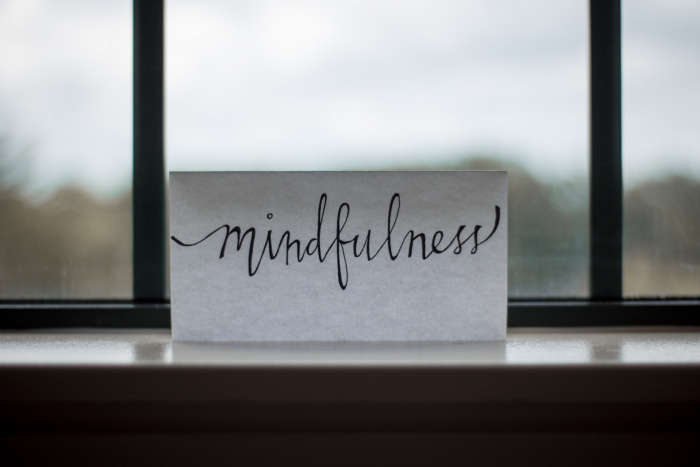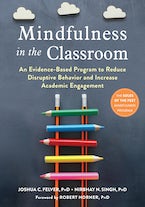By Joshua C. Felver, PhD, ABPP, coauthor of Mindfulness in the Classroom
As a psychologist I frequently work with parents and teachers to discuss ways they can best support their students/children. One topic that frequently comes up is the relation between one’s own stress/mental health, and how an adult’s own stress/mental health directly affects the stress/mental health of the children in their lives. I typically employ the classic “airplane oxygen mask” metaphor to make this point. Anyone who has ever taken a commercial flight has heard the phrase, “in the event of an emergency, please place the oxygen mask on yourself first before assisting the person next to you.” The logic for this suggestion is self-evident: you can’t be in any position to help another if you yourself aren’t functioning optimally. In the same way, this metaphor extends to anyone—parents, teachers, mental health providers—who work with children: you must take care of yourself if you are going to best support the children you interact with.
Despite the fact that every teacher, parent, and peer mental health providers I’ve ever worked with knows the importance of self-care, it has been my experience that these same individuals are among the first to drop self-care from their daily routines when times get busy. It’s my opinion that it is because these same individuals so deeply value supporting children that they are willing put their own well-being to the side so that they can devote extra effort to helping the youth that depend on them. And this makes sense, particularly during highly stressful times. “In the event of an emergency,” it is natural to put the needs of children before one’s own—children can’t take care of themselves and are dependent on adults for safety, survival, and support. Even the thought of putting your own needs before a child feels selfish and inherently wrong. The conflict is that there are many times when the best way one can care for a child is to care for oneself. Self-care is not a self-indulgence for those who work with children; it is a critical requirement of the job.
Contemporary society feels like a never-ending series of slow-motion train wrecks. The COVID-19 pandemic, political turmoil, and process of addressing structural inequities has created a perfect storm of stress and subsequent mental health problems. These stressors are coming on top of troubling demographic trends in youth that include annual increases in the rates of depression, anxiety, and suicide. Those of us who have dedicated significant portions of our lives to helping youth know deep down that our work is needed now more than ever, and that we need to be bringing our best selves to support children in the hopes of a brighter tomorrow. In this context, it is incredibly difficult to prioritize self-care given the great need of children at this moment in time. There has also never been a more important time for self-care in order to meet the needs of today’s youth.
The question then becomes: if we recognize that our own self-care directly affects our ability to care for children, what is the best use of our time? I, and many other mental health providers, argue that some of the biggest detriments of one’s own stress/mental health comes in the form of basic physical maintenance. Regular exercise, good nutrition, and adequate, high-quality sleep are the foundation for good physical and mental health. Beyond this, it is also important that we adults are fluent in our own coping behaviors for encountering highly challenging situations. There are two important reasons for this. First, coping with challenges and stressors is obviously important for our own health. If stress affects us greatly, then we can become quickly overwhelmed and start functioning suboptimally, and therefore, we need to be skilled at coping with stress when it comes. Second, we are very concerned with teaching children these same strategies for coping with life’s challenges, and if we are ourselves are not skilled in coping with stress, we are not able to model these skills for our children and are therefore not able to teach them in the most effective way possible. Why would anyone expect a child to learn a “cool-down” strategy from someone who themselves is unable to keep calm in the face of hardship? Children learn by observation, and adults modeling coping strategies is the most important way that children will learn how to face their own life stressors.
The psychological and teaching literature is replete with manuals, strategies, and tricks for how to cope with stressors. Diaphragmatic breathing, visualizing relaxing environments, and progressive muscle relaxation are the most popular strategies that we teach to children for how to cope with stressors. Recently, the work of myself and others has offered that mindfulness-based programming may teach children similar coping strategies for reducing stress and handling hardships, and there is a growing body of scientific literature in support of the utility of such practices. Nirbhay Singh and my contribution to this literature was recently published in the book, Mindfulness in the Classroom, which describes one such strategy called Soles of the Feet. Just like diaphragmatic breathing, Soles of the Feet teaches children a simple coping strategy for what to do when you feel yourself become upset. We’ve packaged this material in a user-friendly format so that it is easily accessible by teachers, mental health providers, and parents. Research conducted by myself and others suggests that Soles of the Feet is very effective for reducing disruptive behavior that comes about in response to stressors encountered by children.
One thing that I stress to those who are seeking to teach Soles of the Feet, or any other coping strategy, is that they themselves should be highly fluent in the procedure before teaching someone else. Why would you take a guitar lesson from someone who has never picked up the instrument? By this same logic, it is critical that those seeking to support youth who are faced with enormous life stressors be themselves—skilled at navigating the turbulent waters of contemporary, stressful life. “In the event of an emergency,” we should be first be looking inward to make sure that we have our own proverbial “masks on,” and are healthy, grounded, and able to cope with stress. Teachers, parents, and anyone who works with youth must take the time to care for themselves through basic diet, sleep, and exercise to be healthy. And they must take the time to be fluent in managing their own stress. Mindfulness in the Classroom offers one effective evidence-based strategy for adults to consider adopting for themselves and for teaching youth—one among many other effective strategies out there to consider adopting. The important thing to remember is that to best support youth, we must be modeling the very skills we seek to engender in children, and we must be taking care of ourselves to take care of children and to teach them how to take care of themselves. We must do our best during these trying times to help children who are struggling to meet the stressors of the world, and it is through “walking to walk” of self-care that we will rise to this occasion. The children deserve no less.
Joshua C. Felver, PhD, ABPP, is assistant professor of psychology at Syracuse University, and director of clinical training in the school psychology program. Felver teaches courses in child development, child and family interventions, and school-based mental health. His research broadly focuses on the development, implementation, and study of mindfulness-based programming in school and community settings. He directs the Mind Body Laboratory, which studies how mindfulness-based programming implemented in schools can support academic functioning and classroom behavior, and investigates the neurobiological mechanisms of contemplative practices.
Nirbhay N. Singh, PhD, BCBA-D, is clinical professor of psychiatry and health behavior at the Medical College of Georgia, Augusta University, certified behavior analyst, and developer of the Mindfulness-Based Positive Behavior Support (MBPBS) and Soles of the Feet programs. His research focuses on assistive technology, health and wellness interventions, and mindfulness-based programs across the life span that reduce suffering and enhance quality of life. He is editor in chief of Mindfulness and Advances in Neurodevelopmental Disorders.



 2024 Peace Playbook: 3 Tactics to Avoid Clashes with Your Partner
2024 Peace Playbook: 3 Tactics to Avoid Clashes with Your Partner